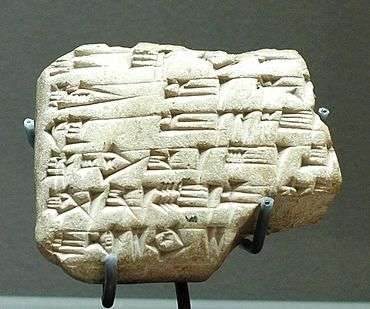Statue of Ebih-Il
|
Statue of Ebih-Il, superintendent of Mari | |
| Material | Gypsum, schist, shells, lapis lazuli |
|---|---|
| Height | 52.5 centimetres (20.7 in) |
| Width | 20.6 centimetres (8.1 in) |
| Depth | 30 centimetres (12 in) |
| Created | c. 2400 BC |
| Period/culture | Sumerian |
| Discovered | 1934 |
| Place | Temple of Ishtar, Mari, Syria |
| Present location | Musée du Louvre, Paris |
| Identification | AO 17551 |
The Statue of Ebih-Il is a 25th-century BC statue of the praying figure of Ebih-Il, superintendent of the ancient city-state of Mari in eastern Syria. The statue was discovered at the Temple of Ishtar in Mari during excavations directed by French archaeologist André Parrot. It is made of gypsum, with inlays of schist, shells and lapis lazuli. Iselin Claire of the Musée du Louvre, where the statue is displayed, describes it as "a masterpiece by virtue of its craftsmanship, state of preservation, and expressive style."[1]
Overview
| Mari |
 Euphrates • Terqa • Tuttul Royal Palace |
| Kings |
| Yaggid-Lim • Yahdun-Lim Yasmah-Adad Zimri-Lim (Queen Shibtu) |
| Archaeology |
| Investiture of Zimri-Lim Statue of Ebih-Il Statue of Iddi-Ilum |
The statue, made of translucent smooth alabaster, depicts the figure of a man seated on a wicker hassock. The man is shown in a praying posture with hands clasped against his chest conveying his devotion to the deity.[1]
The man's head is shaved. His long beard is composed of vertical curls and has holes drilled, and was formerly inlaid with another, now-lost material.[1] The beard accentuates the figure's cheeks and finely sculpted lips that convey a half-smile. The figure's staring blue eyes were crafted with particular care and attention to detail. A combination of schist, shells and lapis lazuli was used to depict the eyelashes and eyelids, cornea and iris, respectively.[2] The lapis lazuli inlays used were imported from as far east as Afghanistan.[1]
The figure has a bare torso and a thin waist. The hands are clasped against the chest, and the left hand is closed and placed inside the right hand.[2] The figure's only dress is the Sumerian-style ceremonial kaunakes skirt. The elaborate fleece skirt appears to be made from animal hide (probably, sheepskin or goatskin) as evidenced by the presence of a tail at the back.[1] The figure's feet are missing but their attachment piece is still showing under the dress.[2]
The inscription of five epigraphic signs on the rear, which identifies the work, reads: "Statue of Ebih-Il, the superintendent, dedicated to Ishtar Virile."[1]
Excavation
The statue was discovered in two parts by the French excavation team under André Parrot.[3] The head was found on the pavement of the outer court of the Temple of Ishtar.[2] The body, along with the smaller statue of King Lamgi-Mari, was found a few meters away.[3] When the statue was found, the left arm and elbow were broken, and the base of the right elbow was shattered.[2] The statues were the first major discovery in the excavations, started in winter 1933, at the site of Mari.[4]
Gallery
 The figure's facial expressions.
The figure's facial expressions. A profile of the statue showing the seated posture and the kaunakes skirt.
A profile of the statue showing the seated posture and the kaunakes skirt. The figure's hands, clasped in prayer.
The figure's hands, clasped in prayer. A closeup of the finely crafted eyes.
A closeup of the finely crafted eyes. A closeup showing the details of the wicker seat
A closeup showing the details of the wicker seat
See also
| Wikimedia Commons has media related to Statue of Ebih-Il. |
References
Citations
Bibliography
- Cluzan, Sophie; Lecompte, Camille; Musée du Louvre. Département des antiquités orientales (2011). Ebih-Il (in French). Paris: Louvre éditions. ISBN 9782757205099.
- Parrot, André (1935). "Les fouilles de Mari (Première campagne)" (PDF). Syria (in French). Institut français du Proche-Orient. 16 (1): 1–28. doi:10.3406/syria.1935.8338.
